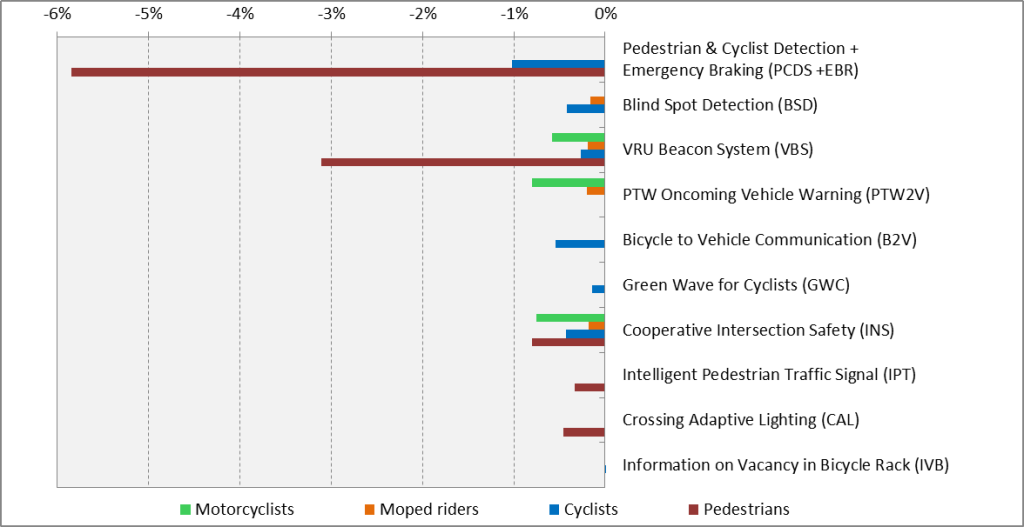The VRUITS project (Improving the Safety and Mobility of Vulnerable Road Users through ITS Applications), co-funded by the European Commission, investigated how safety and mobility of Vulnerable Road Users (VRUs) can be improved through Intelligent Transport Systems (ITS), and provided recommendations on actions to be taken to speed up the deployment of the most promising applications.
Between 2000 and 2012, fatalities among car occupants dropped by 50%, whereas the decrease in VRU fatalities was lower (34% for pedestrians, 31% for cyclists and 17% for Powered Two Wheelers (motorcyclists and moped riders). ITS has assisted in the decrease of road traffic fatalities but the main focus has been on vehicle ITS and vehicle passengers. Consequently, there is a clear need to study how ITS can improve safety and mobility of VRUs.
Impact assessment of ITS systems
The project started by identifying ITS applications which have high potential to improve the safety, mobility and/or comfort of VRUs. Ten of the most promising applications were selected for a more detailed quantitative impact assessment in terms of safety, mobility and comfort, as well as for a cost-benefit assessment.
As an example, the following figure shows the estimated safety impact of these 10 systems, expressed as a percentage reduction of all road fatalities, assuming a theoretical 100% penetration. In terms of safety, the most effective ITS application was Pedestrian and Cyclist Detection System + Emergency Braking (PCDS+EBR) which was estimated to reduce road fatalities about 7%, corresponding to 1,900 road fatalities saved per year when considering the 2012 accident data. Cooperative systems, in which vehicles communicate with VRUs through radio communications showed also relatively high safety benefits for the theoretical 100% penetration: VRU beacon system (VBS), Powered-Two-Wheeler oncoming vehicle information system (PTW2V), Bicycle-to-vehicle Communication system (B2V) and Cooperative Intersection Safety (INS).

Figure 1. Safety impacts (%) of ITS applications on all road fatalities by VRU type in the EU-28 for a 100% penetration rate.
Cost-benefit assessment of ITS systems
A cost-benefit analysis (CBA) weighted the costs and benefits of each selected ITS and provided an estimation on systems which can yield the greatest benefits to VRUs compared to their costs. The overall performance of these systems on an EU level was assessed based on the Net Present Value (NPV) during the period 2015–2030 and their benefit/cost ratio. The benefit/cost ratio was used to indicate whether a system provided sufficient return compared to its cost. Table 1 summarises the results of the CBA.
| Cost-efficiency | Benefit/Cost ratio | |||
| <1 | (1−3) | >3 | ||
| Net Present Value | < 500 M€ | IVB | GWC | B2V, CAL |
| > 500 M€ | PCDS+EBR, BSD | VBS, IPT | INS, PTW2V | |
According to the calculations, 7 out of the 10 systems were assessed to have positive benefit/cost ratios. All cooperative systems (INS, PTW2V, B2V, VBS and GWC) provided a positive return on the costs whereas the in-vehicle systems (PCDS+EBR and BSD) have negative benefit/cost ratios, predominantly due to their high implementation costs.
Trials of innovative ITS systems
During the VRUITS project, innovative ITS applications were demonstrated in Helmond in the Netherlands and in two cities in Spain. The cooperative intersection safety system demonstrated in Helmond included emergency braking and provision of warnings to intelligent bicycles. The intelligent pedestrian traffic signal systems demonstrated in the Spanish cities of Alcalá de Henares and Valladolid included automatic detection of pedestrians using Bluetooth or camera, adaptive illumination of crossings, extension of green light for people with reduced mobility and provision of waiting times to mobile phones.
Conclusions and outlook
Based on the analysis of the 10 ITS systems and the results of the trials, a set of recommendations were compiled for policy makers and industry to improve the safety, mobility and/or comfort of VRUs. The recommendations identified the areas for further research and actions needed to speed up the European wide deployment of the ITS applications.
More information on the results of the project can be found from the project website, including the project deliverables with more details on the calculations and the demonstrations: www.vruits.eu
 Contact: Contact:Johan Scholliers johan.scholliers@vtt.fi VTT, Finland |







Follow us: